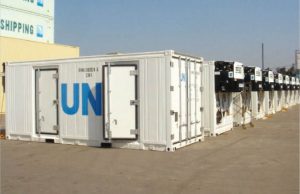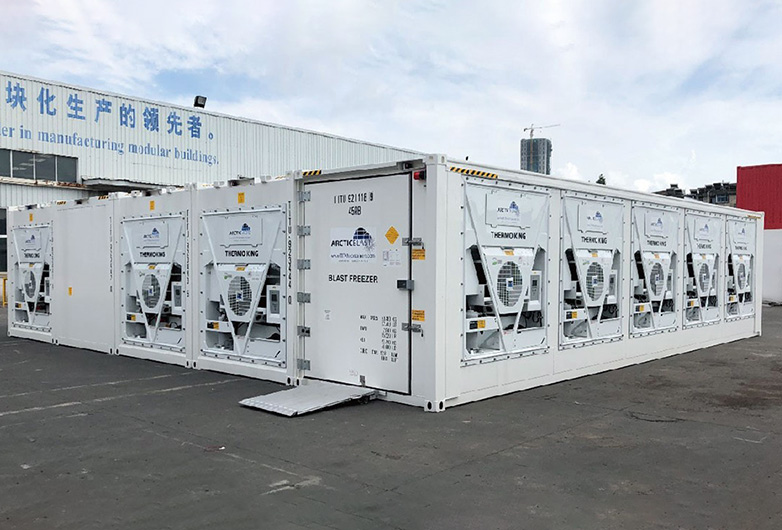Choosing the right size for a prefab cold storage unit is a crucial decision for businesses in industries such as food processing, pharmaceuticals, logistics, and agriculture. Cold storage units are essential for maintaining the quality, safety, and longevity of perishable goods by providing controlled environments with specific temperature ranges. However, selecting an improperly sized cold storage unit can lead to inefficiencies, increased operational costs, and even potential loss of products. This article will guide you through the key factors to consider when determining the ideal size for a prefab cold storage facility, ensuring that it meets your operational needs, space requirements, and long-term growth potential.

1. Assess the Type and Volume of Goods to Be Stored
The first step in selecting the right size for your prefab cold storage is determining the types of goods that will be stored. Different products require varying temperature ranges, humidity levels, and storage configurations, all of which impact the size of the storage facility.
- Perishable Food Items: Food items such as fruits, vegetables, meat, and dairy products require cold storage with precise temperature control to prevent spoilage. The amount of space needed for storing these items depends on factors such as the volume of inventory and the packaging method (e.g., boxes, pallets, crates).
- Frozen Goods: Items like frozen meat, seafood, and prepared meals require storage at much lower temperatures, typically between -18°C to -25°C. These products often require more space due to the bulkiness of freezing equipment and insulation requirements.
- Pharmaceuticals: Medications, vaccines, and biologics need temperature-sensitive storage environments, often between 2°C and 8°C. These products typically require less space than food items but demand higher precision in temperature and humidity control.
- Flowers and Plants: Flowers, seeds, and plants have specific temperature and humidity needs to maintain freshness and vitality. The storage space should account for shelving systems or racks to organize these items.
In addition to product types, it is essential to assess the volume of goods you need to store at any given time. Consider both your current inventory levels and future growth. If your business is seasonal, you might need extra storage capacity during peak periods. A thorough understanding of your inventory volume will help determine whether you need a small, medium, or large prefab cold storage unit.
2. Calculate the Required Storage Space
Once you know the types of products and their volumes, the next step is to calculate the total cubic feet or cubic meters of storage space required. This calculation will help you decide on the dimensions of your prefab cold storage.
Storage Configuration
The way you organize and store your products impacts the overall space requirements. Factors to consider include:
- Pallet Racking: For businesses dealing with bulk storage, such as in food distribution, pallet racking systems maximize vertical storage. Depending on the height of your cold storage, you can stack pallets, which reduces the footprint required but increases the need for precise temperature control at all levels.
- Shelving: Smaller items, such as pharmaceuticals, might require shelving systems instead of pallets. Shelving allows for more organization but may take up more floor space.
- Aisle Width: The width of aisles between racks or shelving affects storage density. Narrow aisles maximize space utilization but may hinder easy access, while wider aisles allow for faster product retrieval, especially with forklift operations.
Volume to Space Conversion
To calculate the required space, consider the volume of each product, how many units you plan to store, and whether stacking is possible. For example:
- Volume of Pallets: Measure the dimensions of each pallet (length × width × height) and multiply by the number of pallets you plan to store. Ensure you account for space between pallets for air circulation.
- Individual Items: For smaller, non-palletized goods, measure the volume of individual items and multiply by the number of units you need to store.
It’s also important to factor in additional space for movement, access, and equipment like forklifts or pallet jacks. A good rule of thumb is to allocate at least 25% extra space for access and operational purposes.
3. Consider Temperature Zones and Segmentation
Different products may require different temperature ranges, so you need to determine whether your prefab cold storage should have multiple temperature zones. For example, a warehouse storing both fresh and frozen products may require separate areas for chilled and frozen storage.
Multi-zone cold storage allows for better space utilization and flexibility, but it also increases the complexity of design and may require additional insulation between zones. Consider the following:
- Separate Chambers: If you need to store products at significantly different temperatures, you may require multiple chambers or compartments, each with its own refrigeration system.
- Adjustable Temperature Zones: Some cold storage units allow for adjustable temperature zones, providing more flexibility in managing different product types within the same facility.
Understanding the number and type of temperature zones required will help determine the overall size and configuration of your cold storage.

4. Account for Operational Workflow and Access
A key aspect of determining the right size for prefab cold storage is considering how the unit will fit into your operational workflow. This includes ensuring efficient access to products, safe handling, and a layout that supports your logistical processes.
Loading and Unloading
Consider the flow of goods in and out of the cold storage:
- Loading Docks: If you have high-volume operations, you may need space for multiple loading docks. This ensures that products can be moved quickly from trucks to storage without significant temperature fluctuations.
- Staging Areas: Many cold storage facilities include staging areas, where products are temporarily held before being loaded onto trucks or moved into storage. Ensure that your storage unit includes adequate space for staging, especially during peak operational hours.
アクセシビリティ
Easy access to stored goods is critical for efficiency. The layout of your cold storage should allow for quick and safe retrieval of products. If you have high turnover, you may need wider aisles and more access points. On the other hand, for long-term storage of goods, a more compact design with less frequent access may be acceptable.
- Material Handling Equipment: Determine if you will use forklifts, pallet jacks, or conveyor systems. Forklifts require wider aisles, while conveyor systems may necessitate special design considerations for integration.
5. Evaluate Future Scalability
When choosing the size of a prefab cold storage unit, it’s important to consider future scalability. While you might only require a certain amount of space today, your business needs could grow over time. Prefab cold storage units are modular, meaning they can be expanded or reconfigured as needed.
- Modular Design: One of the advantages of prefab cold storage is that it can be designed with scalability in mind. Choose a unit that can be easily expanded or subdivided into additional temperature zones as your needs change.
- Long-Term Projections: Consider your long-term business goals and projections. Will you need more storage capacity in the next 5–10 years? Planning for growth now can save significant costs and disruptions down the road.
6. Site Location and Available Space
The size of your prefab cold storage will also be influenced by the available space at your site. Whether your storage unit is being installed inside an existing building or as a standalone structure, you need to account for site constraints.
Indoor vs. Outdoor
Prefab cold storage units can be installed indoors or outdoors, depending on your needs and available space:
- Indoor Units: Indoor units are often smaller and used for more specific storage purposes, such as pharmaceutical storage in hospitals or small-scale food storage. The size of the available building will limit the size of the cold storage unit.
- Outdoor Units: Outdoor installations allow for larger units and easier scalability. However, site preparation is crucial, including ensuring adequate foundation and drainage. Outdoor units also need to be designed to withstand environmental conditions, such as heat, cold, wind, and rain.
Zoning and Permits
Check local zoning laws and building codes to ensure compliance. Some areas may have restrictions on the size, height, or placement of prefab cold storage units. You may also need permits for construction, especially for larger outdoor units.
結論
Selecting the right size for a prefab cold storage unit is a complex process that involves understanding the type and volume of goods to be stored, calculating space requirements, considering operational workflows, and planning for future scalability. By carefully analyzing your current and future needs, as well as the specific demands of your industry, you can ensure that your cold storage unit is appropriately sized to optimize efficiency, reduce costs, and protect your valuable products. The flexibility of prefab cold storage units offers businesses the opportunity to tailor their storage solutions to meet both immediate and long-term needs, making them an ideal choice for industries that rely on precise temperature control and storage efficiency.
CIMC TLC|XLC|RYC is a leading manufacturer of prefab cold storage and various other standard and special logistics equipment. With years of experience in the industry, it focuses on the design, production and distribution of high-quality innovative products that meet the specific needs of customers.


